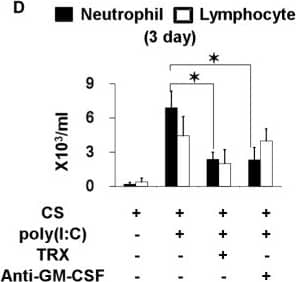Mouse GM-CSF Antibody
R&D Systems, part of Bio-Techne | Catalog # MAB415

Key Product Details
Validated by
Species Reactivity
Validated:
Cited:
Applications
Validated:
Cited:
Label
Antibody Source
Product Specifications
Immunogen
Accession # P01587
Specificity
Clonality
Host
Isotype
Endotoxin Level
Scientific Data Images for Mouse GM-CSF Antibody
Cell Proliferation Induced by GM-CSF and Neutralization by Mouse GM-CSF Antibody.
Recombinant Mouse GM-CSF (Catalog # 415-ML) stimulates proliferation in the DA3 mouse myeloma cell line in a dose-dependent manner (orange line). Proliferation elicited by Recombinant Mouse GM-CSF (0.75 ng/mL) is neutralized (green line) by increasing concentrations of Mouse GM-CSF Monoclonal Antibody (Catalog # MAB415). The ND50 is typically 0.03-0.09 µg/mL.Detection of Mouse GM-CSF by In vivo assay
Effects of TRX on inflammatory cytokines in BALF from exposed to cigarette smoke and challenged with poly(I:C).(A) KC and (B) GM-CSF in BALF obtained 6 h and 3 days after poly(I:C) challenge. (C) Messenger RNA of GM-CSF in lung homogenates 3 days after poly(I:C) challenge in mice exposed to cigarette smoke treated with or without TRX. (D) Neutrophil and lymphocyte counts in BALF 3 days after poly(I:C) challenge in mice exposed to cigarette smoke treated with and without TRX or anti-GM-CSF antibody. Error bars represent standard deviation (SD) (A, B, and C, n = 3–4 per group; D and E, n = 5 per group); *p<0.05. Image collected and cropped by CiteAb from the following publication (https://dx.plos.org/10.1371/journal.pone.0079016), licensed under a CC-BY license. Not internally tested by R&D Systems.Applications for Mouse GM-CSF Antibody
Western Blot
Sample: Recombinant Mouse GM-CSF (Catalog # 415-ML)
under non-reducing conditions only
Neutralization
Mouse GM-CSF Sandwich Immunoassay
Reviewed Applications
Read 1 review rated 5 using MAB415 in the following applications:
Formulation, Preparation, and Storage
Purification
Reconstitution
Formulation
Shipping
Stability & Storage
- 12 months from date of receipt, -20 to -70 °C as supplied.
- 1 month, 2 to 8 °C under sterile conditions after reconstitution.
- 6 months, -20 to -70 °C under sterile conditions after reconstitution.
Background: GM-CSF
GM-CSF was initially characterized as a factor that can support the in vitro colony formation of granulocyte-macrophage progenitors. It is also a growth factor for erythroid, megakaryocyte, and eosinophil progenitors. GM-CSF is produced by a number of different cell types (including T cells, B cells, macrophages, mast cells, endothelial cells, fibroblasts, and adipocytes) in response to cytokine or inflammatory stimuli. On mature hematopoietic cells, GM-CSF is a survival factor for and activates the effector functions of granulocytes, monocytes/macrophages, and eosinophils (1, 2). GM-CSF promotes a Th1 biased immune response, angiogenesis, allergic inflammation, and the development of autoimmunity (3-5). It shows clinical effectiveness in ameliorating chemotherapy-induced neutropenia, and GM-CSF transfected tumor cells are utilized as cancer vaccines (6, 7). The 22 kDa glycosylated GM-CSF, similar to IL-3 and IL-5, is a cytokine with a core of four bundled alpha‑helices (8-10). Mature mouse GM-CSF shares 49-54% amino acid sequence identity with canine, feline, human, and porcine GM-CSF and 69% with rat GM-CSF. GM‑CSF exerts its biological effects through a heterodimeric receptor complex composed of GM-CSF R alpha/CD116 and the signal transducing common beta chain (CD131) which is also a component of the high-affinity receptors for IL-3 and IL-5 (11, 12). In addition, GM-CSF binds a naturally occurring soluble form of GM-CSF R alpha (13). The activity of GM-CSF is species specific between human and mouse. Mouse GM-CSF is only weakly active on rat cells, although rat GM-CSF is fully active on mouse cells (14, 15).
References
- Martinez-Moczygemba, M. and D.P. Huston (2003) J. Allergy Clin. Immunol. 112:653.
- Barreda, D.R. et al. (2004) Dev. Comp. Immunol. 28:509.
- Eksioglu, E.A. et al. (2007) Exp. Hematol. 35:1163.
- Cao, Y. (2007) J. Clin. Invest. 117:2362.
- Fleetwood, A.J. et al. (2005) Crit. Rev. Immunol. 25:405.
- Heuser, M. et al. (2007) Semin. Hematol. 44:148.
- Hege, K.M. et al. (2006) Int. Rev. Immunol. 25:321.
- Kaushansky, K. et al. (1992) Biochemistry 31:1881.
- Diederichs, K. et al. (1991) Science 254:1779.
- Gough, N.M. et al. (1984) Nature 309:763.
- Onetto-Pothier, N. et al. (1990) Blood 75:59.
- Hayashida, K. et al. (1990) Proc. Natl. Acad. Sci. USA 87:9655.
- Pelley, J.L. et al. (2007) Exp. Hematol. 35:1483.
- Oaks, M.K. et al. (1995) J. Interferon Cytokine Res. 15:1095.
- Vandenabeele, P. et al. (1990) Lymphokine Res. 9:381.
Long Name
Alternate Names
Entrez Gene IDs
Gene Symbol
UniProt
Additional GM-CSF Products
Product Documents for Mouse GM-CSF Antibody
Product Specific Notices for Mouse GM-CSF Antibody
For research use only

